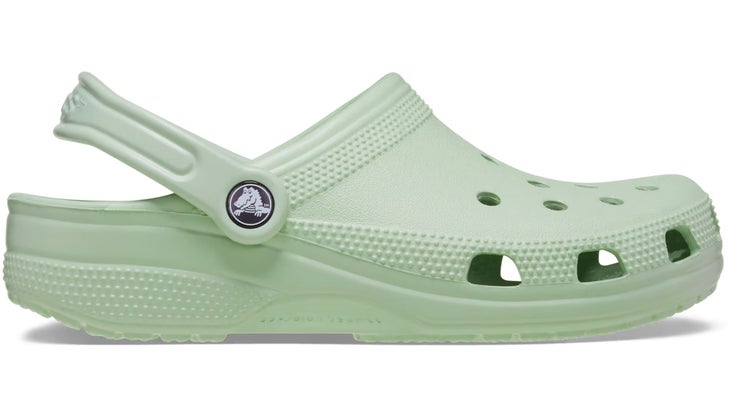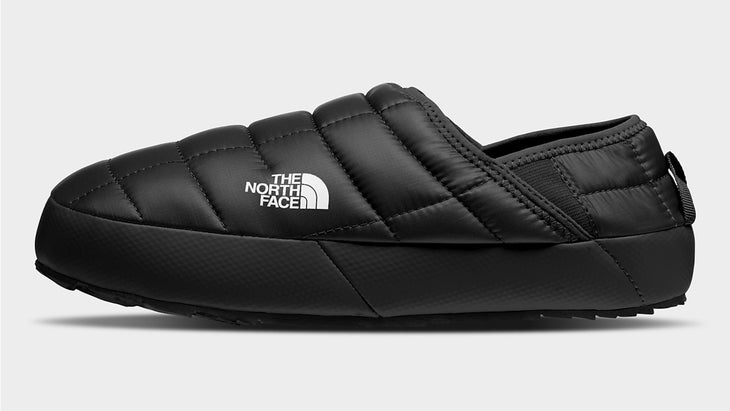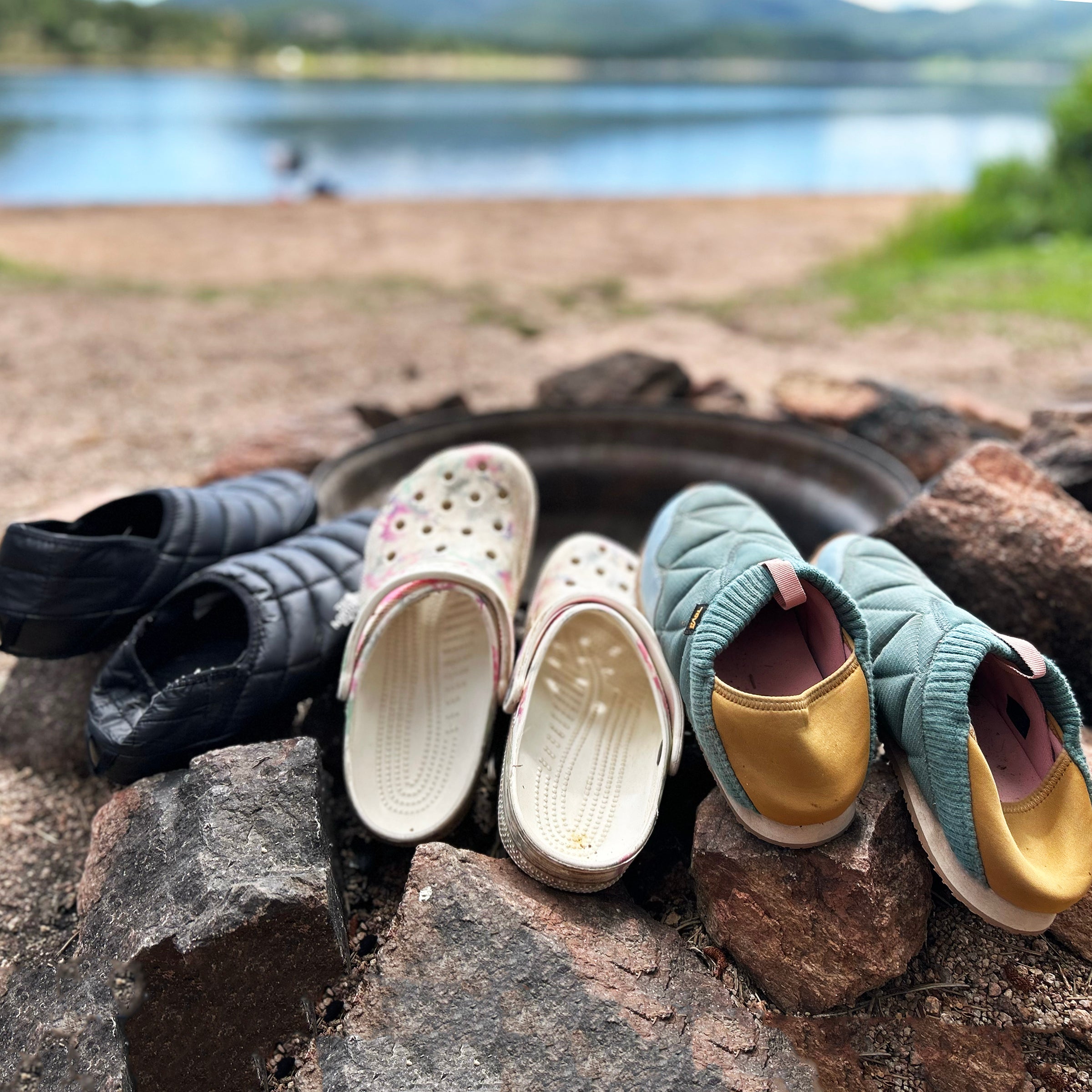There’s nothing wrong with wearing running shoes or hiking boots around camp, whether you’re backpacking or car camping. They work. They protect your feet, as shoes tend to do. But I’m a firm believer in the value of camp shoes—lightweight, easy on-and-off footwear to wear when spending nights outside.
If you’re backpacking, do you really want to keep on those shoes or boots that you’ve hiked in all day while you’re trying to relax and recoup? Do you want to futz with the shoe’s tongue, shove your feet inside the heel collar (still wet from the day’s sweat), and lace up, every time you get out of your tent? Are a few ounces of weight savings worth that?
And if you’re car camping, why not throw a dedicated pair of camp shoes into the car before heading out? Surely there’s room in your vehicle, no matter how stuffed to the gills with gear it may be. Packing camp shoes is worth it.
I’ve put a fair amount of camp shoes to the test over 20-some years of car camping around the Colorado Rockies, plus some lovely nights in Grand Teton, Yellowstone, and Glacier National Parks. I define “camp shoes” as footwear that I can easily slide my feet in and out of while holding any of the following: a sizzling pan of food hot off the camp stove, a beer in one hand and a guitar in another, or a full bladder (and not the kind you put in a backpack). When I’m camping, I don’t want to have to use my hands to tie or untie shoes, especially in the middle of the night when exiting my tent for a bathroom break. And I certainly don’t want to tie my shoes in the morning before breakfast. Save the tying of things until after I’ve had my coffee.
Car camping, to me, is all about relaxing in the woods—cooking, lounging, enjoying company, and sliding in and out of comfy shoes. And I don’t want hiking boots or running shoes laced up and applying pressure on my feet in any way. I prioritize comfort, convenience, and functionality—and camp shoes deliver on all three.
Two pairs of camp shoes have stood the test of time for different reasons, and a third recently entered my rotation and will have a longstanding stint. Each excels in a different camping setting and season, so I’m breaking down the pros and cons of the three to help you home in on shoes that suit your camping style.
If you buy through our links, we may earn an affiliate commission. This supports our mission to get more people active and outside. Learn more.

Best for Warm Weather and Waterfront Camping
Crocs Classic Clogs
Yeah, Crocs. Rubber shoes. However you may feel about Crocs, feel this: They’re super-easy to step in and out of, nobody’s feet have ever overheated in a pair of Crocs, and no other pair of shoes dries quicker. For those reasons, Crocs Classic Clogs work great for camping in hot temperatures, or for camping on a lake where you may be in and out of the water. The tread pattern underfoot provides traction in dirt, should you venture on a short walk or hike. And if temperatures dip, you can always rock socks with Crocs.
Bonus: Crocs are super lightweight and can be clipped to the outside of a backpacker’s pack.
Downsides: Your feet can get awfully dirty wearing Crocs in a campsite, and Crocs are bulky inside a duffle bag or backpack.

Best for Cold Nights and Mountain Camping
The North Face ThermoBall Traction Mules
Nothing is cozier than a puffy jacket, and these mules are basically a puffy jacket for your feet. The baffled upper is stuffed with 100 percent recycled polyester insulation and enclosed in a water-repellent shell, making chilly mountain air—campfire or no campfire—no match for them. Add to the upper a soft, velour-like fleece insole and interior lining and the cozy level of these slippers is off the charts. The warmth of the polyester fill and water-repellent shell combined with the rubber outsole with traction makes these a good choice for unpredictable mountain weather and apparently makes them appealing to teenage boys for wearing to school in the winter—or at least my teenage boys.
Bonus: They can be worn as mules with the heel collar down or as shoes with a loose, slip-in fit that stays surprisingly secure.
Downside: They can feel too warm at lower elevations mid-summer.

Best for Moderate Temperatures and Crossover Casual Wear
Teva ReEmber
These slipper-like shoes are insulated with a recycled polyester microfiber encased in recycled ripstop and polyester shell. They’re less puffy, and therefore, less toasty, than the ThermoBall Mules, making them ideal for moderate temperatures during shoulder season or summer camping trips with cool to cold nights. The outsole, made of 50 percent recycled rubber, provides adequate traction and protection. These even work for around-town wear, depending on the town (in Boulder, they pass as “cool shoes.” Like the ThermoBall Mules, the ReEmber shoes can be worn as a mule with the heel collar flattened, or as a shoe, making them easy to step in and out of.
Bonus: The toe cap, reinforced with a panel made out of 60% polyester and 40% polyurethane, protects in a toes vs. log/picnic table/fire grill situation.
Downside: The footbed feels a bit firm and flat—I crave a little cushion or contour while puttering around camp and walking the dog.


